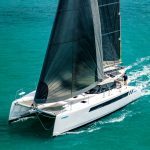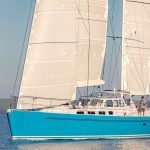‘Behemoth’ is a word which springs to mind or, perhaps more nautically, ‘leviathan’.
- Her eco credentials – clever design for a minimalist footprint
- Construction – seriously strong to handle extreme sailing
- Very comfortable interior – if you’re going to visit obscure destinations, you may as well do it in style



 Wind Spirit, ready to take on the world.
Wind Spirit, ready to take on the world.

















